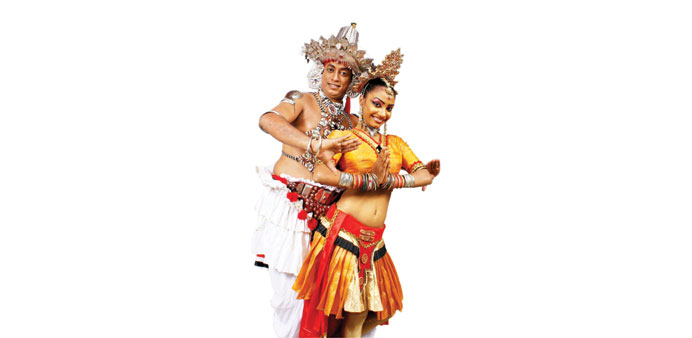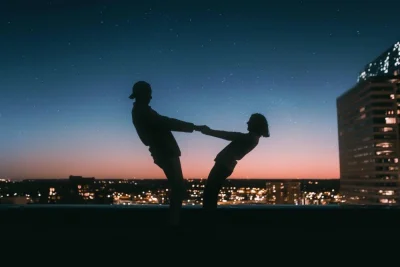—Chandana Wickramasinghe, Dance guru
For Sri Lankan choreographer
Chandana Wickramasinghe,
dancing has been a childhood
passion. Now, his academy,
Chandana & the Dancers’ Guild
of Sri Lanka (CDGSL), has become
the cultural torchbearer for the
Pearl Island. By Umer Nangiana
|
|
It was exuberance personified. They came down from the Pearl Island — as Sri Lanka is known — and swept every one off their feet. In an air of tranquility, everyone danced — the peacocks, the mermaids and the cobras. In such an ambience, celebrating freedom never felt any better.
From the moment the girls attired in traditional Sri Lankan dresses stepped on to the stage, they sent the audience of more than 500 people into a trance, performing for the next five hours with remarkable élan.
With Urumaya, a traditional dance from Kandy, to bless the audience with peace and prosperity, they exercised the exact cultural pull that the Sri Lankan community in Doha was looking for.
The man pulling all the right strings at the right time from behind this spectacular show of the ‘dancing flames’ was none other than dance guru Chandana Wickramasinghe.
The young boys and girls performing the traditional dance forms were artistes from his academy, Chandana & the Dancers’ Guild of Sri Lanka (CDGSL). They were here for Nidahas Udanaya 2014 — to celebrate the 66th Independence Day of Sri Lanka with their community.
By organising the art show, the Sri Lankan embassy in Doha and Sri Lanka Coordinating Committee (SLCC) not only brought together community members under one roof, they also provided a feast for all music and dance lovers.
Wickramasinghe ran the show with his selection of music, traditional costumes for the performers and choreography. But he was par excellence at mixing different dance forms to create a fusion of the traditional and contemporary.
“This was based on all three types of traditional dances: Kandyan from the hill top; Pahatarata from the bottom end of the island; and Sabaragamuwa from the central province,” Wickramasinghe, the choreographer and the Director of CDGSL, told Community after the show.
After a little effort, I managed to catch him for a brief chat. He appeared from the backstage, attired in a traditional yet stylish Sri Lankan dress with his shirt resembling a short kurta over matching baggy trousers.
He was smiling, and why not — the choreographer had just concluded another marvelous show. I asked him about Kanya, the dance of the virgin. It was one of the fusion dances where he combined his own innovative techniques with the traditional dance form.
“It is a very traditional dance dating back hundreds of years in Sri Lanka. Here in the show, I combined all three traditional forms. In the second half, I introduced my own innovations,” Wickramasinghe disclosed. He said his troupe has performed it in more than 65 countries and received appreciation from everywhere.
One brilliantly choreographed act pertained to a single male moving from one girl to the other in rhythmic movements. Under dramatic light effects, they carried along white satin sheets syncing them into their overall dance form.
“Was this a love story,” I asked.
“We call it divine love. Actually, this time it was only seven people, mostly it is one man and several girls. Basically, it was something that came to my mind while dancing on the stage once,” recalled Wickramasinghe.
“It is a normal thing. There are many beautiful girls that a man comes across in life. So this guy is searching for the one for him to spend the rest of his life with,” he explained.
The master choreographer said he puts this act with all his traditional dances in all his shows and “people like it.” The dance guru believes that it is his innovations and love for creativity that makes him stand out where cultural dance is concerned.
“Since our inception we have built up an enviable reputation for innovation and creativity. At the heart of our work is utmost sincerity and excitement of the performer’s physical presence and unison between dancer and the audience. Our humble attempt is to touch that hidden world of emotion and imagination,” he emphasised.
Among some other performances by artistes from the Wickramasinghe academy included Abishek — no, nothing to do with the famous Bollywood Bachchan clan. It is a dance form which is a combination of traditional music and traditional drums beating to different rituals and dances carried out in Sri Lanka since the ancient times. However, the group did perform pieces choreographed from popular Hindi movies, including Devdas.
Mayam was another dance form essayed by beautiful Sri Lankan girls dancing with water pots. It is a ritual dance for healing, one was told. A dance act with sea horses and mermaids dancing at the bottom of the beautiful ocean surrounding Sri Lanka was their next act.
The girls and a boy in costumes resembling peacocks followed in a performance entitled Ranamonaru: it is a fusion act where a young peacock flirts with peahens. Peacock has a special place in Sri Lankan culture.
Ves, a traditional dance from Kandy, performed at festivals and celebrations with drummers and dancers, was also a part of the performance.
The variety in the colourful dances depicted the richness of Sri Lankan culture. Wickramasinghe proved to the audience why poet and philosopher Rabindranath Tagore dubbed Sri Lanka as ‘the pearl of the Indian Ocean.’
Just as well, the choreographer has studied at Tagore’s University in Shantiniketan, which he joined in 1994 and where he learnt the Kathakali and Manipuri style of dance. His profile states that he learned his first steps in dancing from Vajira Chitrasena, a pioneering Sri Lankan dancer, at the age of six.
He completed his schooling in ‘science’ subjects from Mahanama College Colombo, with no reference to his prowess as a dancer. It was, in fact, at the end of his school that he joined the Sama Ballet troupe as a dancer where he spent the next eight years.
Wickramasinghe has danced before audiences in many cities in Europe and Asia. Participating in dance festivals around the world as a dancer and choreographer, he showed his prowess at the world famous Saddlers’ Wales theatre in London in 1990.
He found his own academy and the company CDGSL which has seven academies with 4,800 students and 40 professionals working under his supervision. He has so far performed in more than 65 countries, including Holland, UK, Malaysia, Pakistan, Belgium, Maldives, Singapore, Nepal, France, Italy, Bulgaria, Jordan, Japan, India, Qatar, South Korea, Taiwan, Oman, UAE and Germany.
So what inspired him to become a dancer? Wickramasinghe says it has been a childhood passion. “I use my art and dance to spread harmony in the world. It is the best thing to have happened to me,” said the master dancer.
The artistes, he added, are cultural ambassadors. Even though his work is drawn heavily from Indian culture, he maintains his love for the culture of his motherland. Wickramasinghe however, believes that a metamorphosis of all cultures makes dance more beautiful.
The Independence Day show also featured a band of singers called Shayara. Gayani Madusha, one of the rising stars from Sri Lanka, also enthralled the audience with her melodious voice while a male singer Priyantha Fernando was equal to the task as well.
George Bandula, president of the SLCC, said the gathering is an annual feature in Doha, made possible with the Sri Lankan embassy’s assistance.
“It is an effort to gather Sri Lankans in Doha under one umbrella where they can enjoy their home culture,” said Bandula.
The next such gathering is likely to be in April this year with their New Year celebrations, the SLCC president concluded.
Chandana Wickramasinghe and his dancing partner showcase a traditional dance form.
Photo courtesy: Chandana Wickramasinghe



